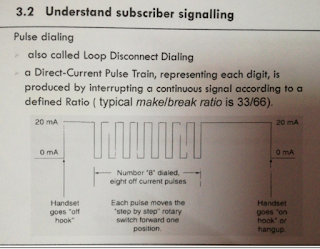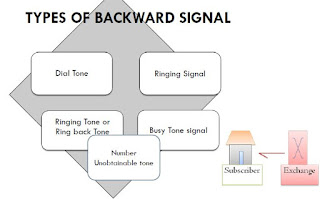TYPES OF BACKWARD SIGNAL
1. Dial Tone
2.Ringing Signal
3.Ringing Tone or Ring back Tone
4.Busy Tone signal
5. Number Unobtainable tone.
Monday, 2 October 2017
Line signaling is a class of telecommunications signaling
protocols. Line signaling is responsible for off-hook, ringing signal, answer, ground start, on-hook unidirectional supervision messaging in each direction from calling party to called party and vice versa.
Line signaling is a class of telecommunicationssignaling protocols of telephone numbers of called party and in more modern line-signaling protocols, the calling party as well.
* Concerned with conveying information on the state of the line or channel.
* Example : on hook , off hook , ringging signal
* Is a supervisory signal and may appear in the circuit anytime
* used to set up and clear down the call and represent events that occur on the trunk such as seizure , proceed-to-send, answer and clear forward.
THIS IS WHAT WE CALL OUT OF BAND SIGNALLING WHICH IS ONE OF THE SIGNALLING CATEGORIES
2) SIGNALLING INFORMATION IS CARRIED IN A DIFFERENT CHANNEL CALLED SIGNALLING LINK
3) ALLOWS FOR THE TRANSPORT OF MORE DATA AT HIGHER SPEED SINCE SETIUP SIGNALS AND TRANSMISSION OF USER MESSAGES CAN BE SENT SIMULTANEOUSLY.
4) OUT OF BAND SIGNALLING - THE SIGNALLING IS TRANSMITTED OUTSIDE THE FREQUENCY BAND OF SPEECH SIGNAL.
Types of Backward Signal
Dial Tone Signal

-The Dial Tone signal is used to indicate that the switching equipment has recognized that a telephone has gone off-hook, and the switching equipment is prepared to receive the dialed digits or DTMF codes.
-The tone stops when the first number is dialed
-Dial tone is a continuous tone having frequency of 425 Hz in Malaysia
Ringing Signal
-The telephone exchange will issue a ringing signal to acknowledge subscriber for incoming call.
-It is a double ring, repeated regularly. It has a low frequency of 20Hz or 25Hz with a cadence of 0.4sec on 0.2sec off 0.4sec on 2.0sec off.
Ringing Tone Or Ring Back Tone
-The telephone exchange will issue a ringing tone to acknowledge the caller that the call is connected is a double ring, repeated regularly.
- It has a frequency of 425Hz with a cadence(modulation)of 0.4second on 0.2second off 0.4second on 2.0second off
Busy Tone Signal
-The telephone exchange will issue a busy tone to the calling subscriber that indicates failure to complete the requested connection.
- Meaning that, at that moment the called subscriber is in off-hook state. Busy tone is also known as engaged tone.
-Busy tone has a frequency of 425Hz and equal length on and off tones (0.5second on 0.5second off).
Number Unobtainable Tone
-It is a voice message issued by telephone exchange when the dialed number is no longer in the service.
example : ‘The number you have dialed is not in service’
Open System Interconnection (OSI) Reference Model
- The OSI has 7 layers that describe the tasks that must be performed to transfer information on the network.
- When data is being transferred over a network, it must pass through each layer of the OSI model.
- As the data passes through each layer, information is added to that data. At the destination, the additional data is removed.
- Layers 4 through 7 occur at the end node, Layer 1 through Layer 3 are the most important to telecommunications network.
Sunday, 1 October 2017
SIGNALLING??
Signalling in telephony is refers to the exchange of control information in the establishment of a telephone call on a telecommunications circuit.
Subscribe to:
Comments (Atom)
TYPES OF BACKWARD SIGNAL 1. Dial Tone 2.Ringing Signal 3.Ringing Tone or Ring back Tone 4.Busy Tone signal 5. Number Unobtainable ton...

-
Dial Tone Signal -The Dial Tone signal is used to indicate that the switching equipment has recognized that a telephone has ...
-
- The OSI has 7 layers that describe the tasks that must be performed to transfer information on the network. - When data is being tr...














